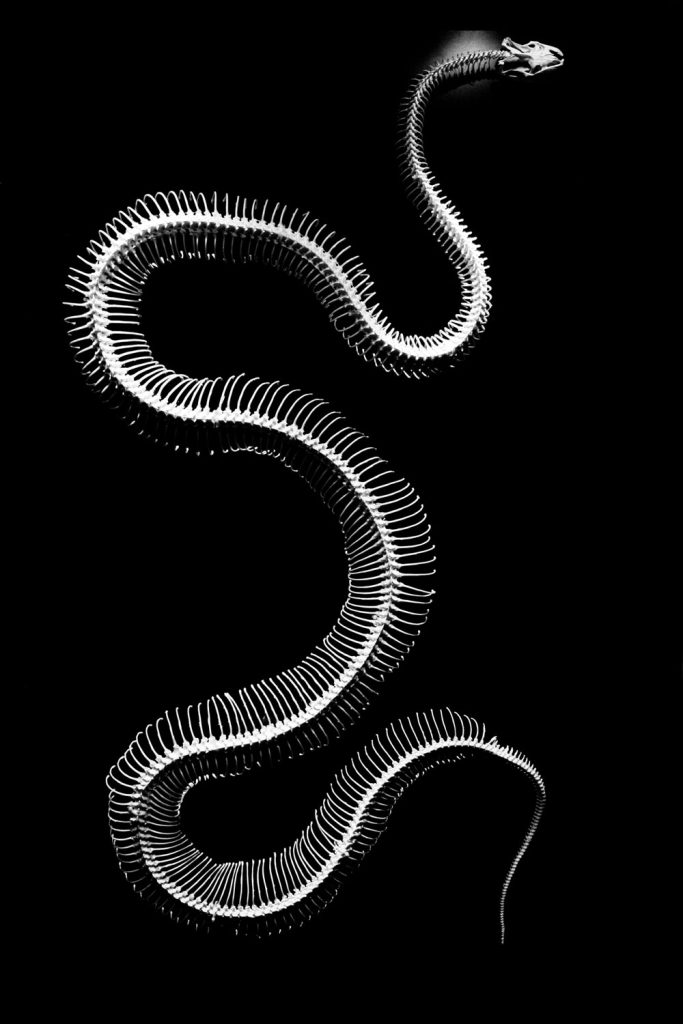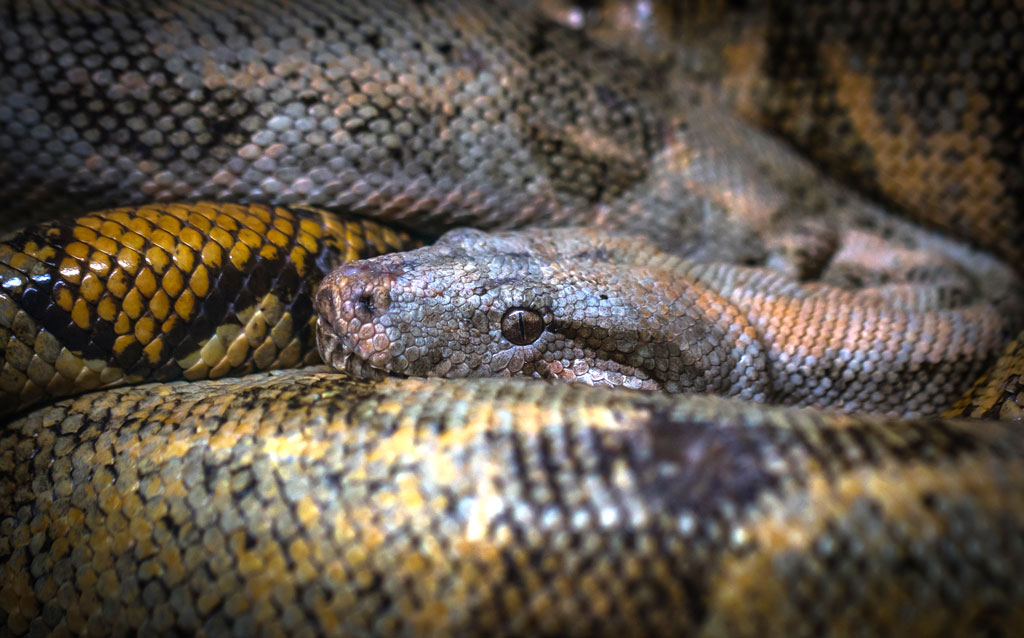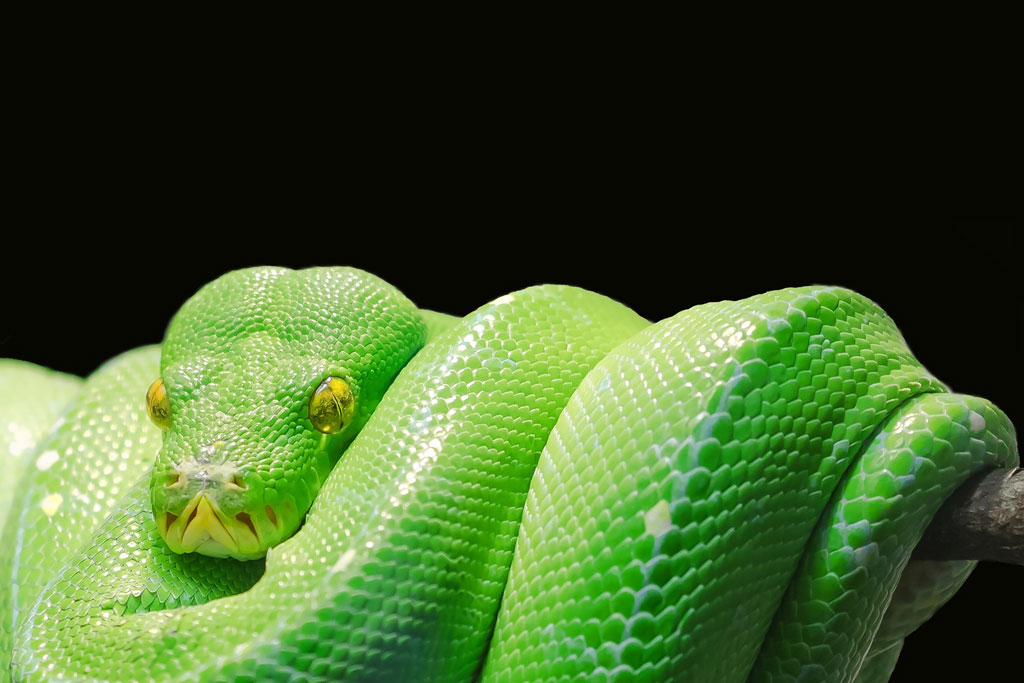We want to help you understand these animals better, especially if you’re going to have pet snakes or avoid snake bites in the wild. Let’s delve deep into it!
Do snakes have bones?

Snakes do have bones. Depending on the species, snakes may have anywhere between 600 and 1400 bones. Snakes are so flexible that they don’t seem to have bones. Despite their deceiving rubbery looks, their elongated bodies require hundreds of bones (more than humans) to hold together. Since they have bones, snakes belong to a group of animals called vertebrates.
The purpose of bones on snakes is to provide strength and structure. Compared to other vertebrates, snakes need many bones to be strong and flexible. The muscles that enable movement attach to the bones, spreading out to other parts of a snake’s body. Apart from a unique skull, snakes also have a long spine with hundreds of vertebrae (bones consisting of the backbone). Their bodies also consist of hundreds of ribs running from the head down the entire body. The ribs protect the animal’s internal organs from possible environmental harm. Some snake species also have vestigial remnants of the pelvic girdle, having diminished due to unuse.
However, snake bones aren’t just for enabling movement and protecting internal organs. They also work together with the muscles when the snake needs to strangle or squeeze prey. Once such a snake catches prey, it coils around it, pressing hard until the animal dies. Such snakes need super strength to manage that.
Do snakes have ears?
Yes, snakes have ears – their fully-formed ears sit right under the skin and are not visible from the outside. Instead of utilizing an eardrum, the ears connect directly to the jawbone, which stays on the ground as they move. Through the jawbones, they detect sound vibrations from the air and tremors caused by feet to detect the presence of another animal.
Can snakes hear? Are snakes deaf?
Yes, snakes can hear. They are not deaf. The misconception that snakes are deaf comes from the lack of visible external ears. Because of the smooth skin on their heads, people have erroneously concluded that snakes are deaf. It turns out that snakes hear when their jawbones capture air and ground vibrations resulting from predator or prey footsteps. As the jawbone vibrates, it relays a signal to the brain through the inner ear, helping the snake interpret happenings in the environment.
Scientists had erroneously concluded that snakes couldn’t hear any sound. Researchers discovered that snakes do indeed respond to sound relayed through the air in a new scientific study. The researchers attached electrodes to the snakes’ heads to measure their reaction to sound from the environment. They suspended a speaker above the snake cage and played sounds through it. Then, they measured whether the snake’s nerves relayed any electrical pulse whenever they played a sound via the speakers. At frequencies between 80Hz and 160Hz, the snakes produced the most powerful vibrations.
The snakes didn’t seem to produce any pulses in response to vibrations resulting from the sounds hitting the ground from observation. If anything, these vibrations were too weak for the snake to pick up. Instead, the sensor they had attached to the snake’s head picked up strong vibrations due to the snake sensing sound directly from the air. Through that elaborate experiment, the scientists proved that snakes do indeed hear, dispelling any notion of them being deaf.
However, there could be variations among different snake species regarding how easily they can sense sound from the air. According to the researchers, some snake species are more capable of sensing vibrations from the ground than sound waves in the air. Snakes need the ability to feel ground waves and sound in the air to detect a wide variety of noises. To enhance their ability to interact with the environment, snakes might also have some special sensors in their skin. However, that requires additional scientific research before concluding that it is, indeed, the case.
Do snakes sleep?
Yes, snakes do sleep. When they sleep, snakes don’t need to „close their eyes.” Instead, they engage their brains to go into a state of sleep. Thus, the animal could have wide-open eyes and still be fast asleep. And that presents a problem when it comes to knowing that a snake is asleep.

The following are some of the things that effect a snakes’ sleeping habits:
It Depends on the Snake Variety
Different snakes go to sleep at other times, depending on the day they have to stay active. During the day, those that are active are the diurnal snakes, including Sipos, racers, patch-nosed, and hog-nosed snakes. Diurnal snakes tend to sleep during the day; therefore, identifying them can help you avoid waking them. However, broad-hades and night snakes would rather stay awake at night and sleep in the daytime.
But that isn’t conclusive, given that some snake types are prone to changing their sleeping patterns over time. You will find the rat snakes in that category, which vary their routine based on the year’s time. Therefore, it can be difficult to tell when these types of snakes are asleep. Furthermore, using the snake type may not conclusively help you know if it is sleeping. That’s why you need to look at other indicators of a sleeping snake.
Seasonal Effects
Snakes may reduce or increase their sleeping time depending on the prevailing season. In winter, most of these reptiles may sleep for up to 16 hours a day. However, that could increase significantly to 20 hours during winter.
In the colder season of the year, snakes become less active, going into a form of hibernation called brumation. The brumation state snakes my sleep for up to 20 hours only to wake up to look for food. After they have found and eaten food, they return to the state of brumation until the next time they require a meal. In the colder regions of the world, snakes may go into brumation for up to seven months.
At that time, it becomes scarce to spot a snake since most of them are hiding in rodent or squirrel dens. Some may find solace in caves, deep caverns, or under tree stamps. While a snake may occupy its hole, there are instances when several snakes inhabit the same den to benefit from the collective body heat. Therefore, it is not uncommon to find male, female, and baby snakes sharing the same space for survival.
Post-Feeding Nap
Snakes may also go to sleep soon after eating a heavy meal. The reptiles may become drowsy and sleep for up to 20 hours a day until they digest the food. They may fall into the rapid eye movement (REM) sleep pattern or slow-wave sleep until they finish digesting the food in their bellies. They use spectacles (or transparent protective shells) to protect their eyes, one for each eye. Apart from protecting the eyes from falling objects, the brille protects against possible drying out.
How to tell if a snake is sleeping
Sleeping snakes look pretty similar to awake snakes. However, you are likely to notice certain clues that tell you when a snake is asleep with careful observation. For example, sleeping snakes tend to:
- Stay in the same position for a long time. Even though they behave the same way during hunting, the duration isn’t as long compared to when they are asleep.
- Not flick their tongue and do not react when you move into the area
Do snakes have eyelids?
No, snakes do not have eyelids. There is a thin membrane called brille, ocular scale, eye cap, or spectacle in the place of eyelids. It is a layer of disc-shaped, immovable, transparent skin covering the snake’s eye. The eye cap protects the cornea from injuries by physical objects in the environment. It also prevents the aqueous humor from desiccating, ensuring the eyes remain functional throughout the snake’s lifetime.

Since brille is part of the skin, it is shed off whenever the snake sheds the skin and is not considered an eyelid. Because of the continuous nature of the spectacle, snakes never seem to be capable of crying. However, like other reptiles, the animals do cry. The tears they shed disappear behind the brille instead of showing up through the eyes. Just before a snake sheds its skin, the eyes become bluish-grey. After that, the snake rubs the mouth against a sharp object before pulling hard to peel the skin.
Are snakes cold-blooded?
Yes, snakes are cold-blooded animals, just like all other reptiles. They are part of the class of animals that must use the environment to help regulate or maintain their body temperature. Therefore, snakes tend to keep the same temperature as that of their surroundings. In cold areas, their bodies will be cold. However, when they move to warmer places, their bodies tend to warm up by taking on the environment’s temperature.
Their cold-blooded nature doesn’t mean that snakes will survive in icy environments. That’s the reason the reptiles go into brumation (dormancy) during winter. In freezing weather conditions, the animals would instead burrow into a cave, crevice, or under a log to survive. Also, snakes cannot stay in places with freezing weather throughout the year. No wonder there are no snakes in the arctic circle or Antarctica.
What animal eats snakes?
Snakes are predators; however, these reptiles may also fall prey to other animals. If you have a pet snake, you need awareness about the various animals that eat snakes to provide better protection. Animals that eat snakes include owls, secretary birds, alligators, snapping turtles, weasels, raccoons, foxes, bobcats, coyotes, and other snakes.
Birds such as eagles, hawks, and owls, which prey on snakes, have incredible eyesight. They can spot snakes from more than 100 meters above the ground. Their swift movements help them swiftly get to the snakes before they can move away. They also have fresh-rending beaks and talons that tear into the flesh, reducing the snake to a simple meal. Some of these birds can also swallow small snakes whole, digest the meat before regurgitating the bones.
However, snakes also eat each other. That’s because snakes have a streamlined shape that makes it easy for another snake to swallow them. A good example is a Kingsnake, a North American native that eats copperheads, rattlesnakes, and pit vipers. Since they have immunity against venom from other snakes, they have no qualms constricting their fellow reptiles to death.
Predators don’t have to wait for snakes to mature before eating them. Some may attack defenseless snake eggs while others wait for babies to hatch. Still, some predators only prefer to eat adult snakes. But so far, we have discussed predators that eat snakes raw. As part of the animals that eat snakes, humans may kill and cook these reptiles in various dishes. You might be surprised to learn how much humans have made snakes an integral part of their cuisine. But that’s a story for another day.

Lydia King is a huge animal lover and has always been fascinated with learning about the animal kingdom. She enjoys writing about anything animal related from scientific information about rare species to animal references in pop culture.












